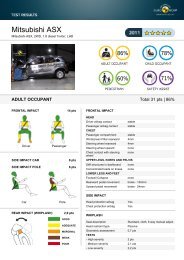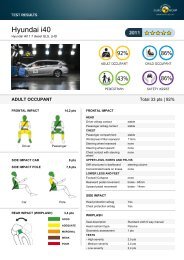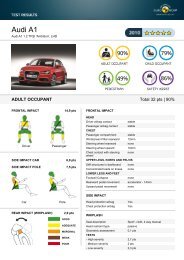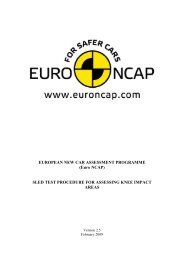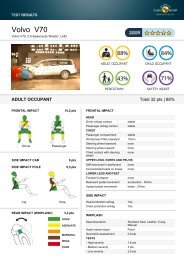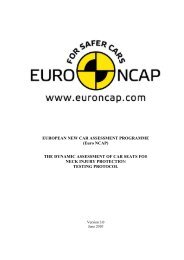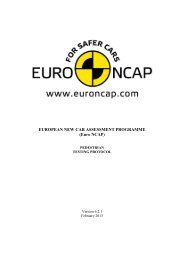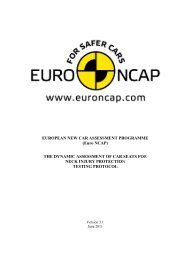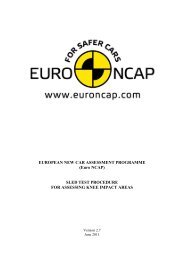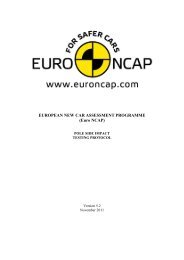Pedestrian Test Protocol - Euro NCAP
Pedestrian Test Protocol - Euro NCAP
Pedestrian Test Protocol - Euro NCAP
You also want an ePaper? Increase the reach of your titles
YUMPU automatically turns print PDFs into web optimized ePapers that Google loves.
12 HEADFORM TESTING<br />
12.1 Description of Headforms and Their Instrumentation<br />
12.1.1 The headforms used shall conform to that specified in Regulation (EC) 78/2009 of the<br />
<strong>Euro</strong>pean Parliament and of the Council (14th January 2009) and annexed in<br />
Regulation (EC) 631/2009 (22nd July 2009).<br />
12.1.2 The child/small adult impactor to be used is defined in Part V (<strong>Test</strong> impactors), no. 3<br />
of the Annex of Regulation (EC) 631/2009. The adult impactor to be used is defined in<br />
Part V (<strong>Test</strong> impactors), no. 4 but excluding no. 4.1.1 of the Annex of Regulation (EC)<br />
631/2009.<br />
12.1.3 Instrumentation:<br />
Version 7.0<br />
March 2013<br />
Location<br />
Centre of gravity of<br />
headform<br />
Centre of gravity of<br />
headform<br />
Centre of gravity of<br />
headform<br />
Measurement<br />
Fore/Aft<br />
acceleration 3<br />
Vertical<br />
acceleration<br />
Lateral<br />
acceleration<br />
CFC<br />
1000<br />
1000<br />
1000<br />
CAC<br />
500g<br />
500g<br />
500g<br />
No of<br />
channels<br />
12.2 Certification - Dynamic<br />
12.2.1 The certification procedures are detailed in Regulation (EC) 631/2009 (22nd July<br />
2009).<br />
12.2.2 The headforms 6 shall be certified before the test programme.<br />
12.2.3 The headforms 6 shall be certified after a maximum of 20 impacts.<br />
12.2.4 The headforms 6 shall be certified at least once every 12 months regardless of the<br />
number of impacts they have undergone.<br />
12.2.5 If the headforms 6 exceed any of their CACs then they shall be re-certified.<br />
12.3 <strong>Test</strong> Procedure - Pre <strong>Test</strong><br />
12.3.1 Ensure that the vehicle is fully test prepared as described in Section 1.<br />
12.3.2 Ensure the vehicle is at the same ride heights as those recorded during marking up of<br />
the vehicle.<br />
12.3.3 Ensure that the headforms, the vehicle, the propulsion system and the data acquisition<br />
equipment have soaked in a temperature in the range of 16C to 24C for at least 2<br />
hours prior to testing.<br />
12.3.4 Fit the required headform to the propulsion system. A child/small adult headform<br />
impactor shall be used for tests to the forward section of the bonnet top, A-pillars,<br />
windscreen, roof (labelled C in Section 3.10), with the test locations lying between<br />
boundaries described by wrap around distances of 1000mm and 1500mm. An adult<br />
headform impactor shall be used for tests to the rearward section of the bonnet top<br />
(labelled A in Section 3.10), with the test locations lying between boundaries<br />
described by wrap around distances of 1700 mm and 2100 mm. Where test locations<br />
3 Relative to the direction of motion of the headform<br />
6 Headforms consist of headskins, aluminium sphere and instrumentation<br />
1<br />
1<br />
1<br />
49



